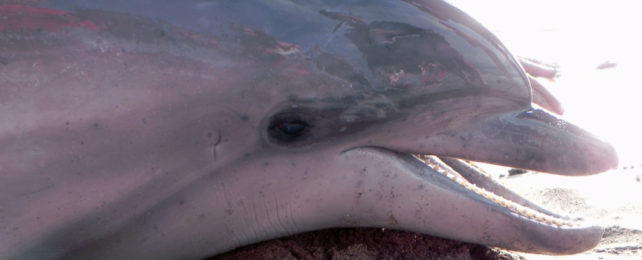Scientists have discovered markers of Alzheimer's disease in the brains of three different species of dolphin found deceased, stranded onshore.
Evidence of mass cetacean strandings exists from before our own recorded history, yet why dolphins and whales beach themselves in groups is an enduring mystery.
While a direct link has been found between naval sonar and some beaked whales, and some individual animals washed up on shore have been clearly unwell, some with a belly full of plastic waste, most mass strandings provide little to no clues.
Toothed whales (Odontocetes) share a number of traits with humans, including (in at least five species that we know of) menopause. Their ability to live well beyond their reproductive years means they have the potential to be susceptible to late-onset diseases as well.
Alzheimer's is the most common cause of disability in aging humans, gradually impairing memory, learning, and communication. Now it appears a similar affliction may impact our water-dwelling mammalian relatives too.
"I have always been interested in answering the question: do only humans get dementia?" says neurobiologist Frank Gunn-Moore from University of St Andrews in Scotland.
"Our findings answer this question as it shows potential dementia associated pathology is indeed not just seen in human patients."
Leiden University biologist Marissa Vacher and colleagues examined the brains of 22 stranded dolphins to search for the biochemical markers present in humans with Alzheimer's. These include amyloid-beta plaques, which while no longer thought to be a direct cause of the disease are still present in elevated numbers in those who have it; and clusters of tau proteins with hyperphosphorylation – when phosphate groups have been added to all possible binding sites on the protein molecule.
They found accumulations of amyloid-beta plaques and hyperphosphorylated tau in three dolphins, each from a different species: the long-finned pilot whale (Globicephala melas), the white-beaked dolphin (Lagenorhynchus albirostris) and the common bottlenose dolphin (Tursiops truncatus). These individuals also had signs of being elderly such as worn or lost teeth and an increase in the ratio of white to grey matter in brain tissues.
What's more, the locations of brain lesions found in the dolphins matched with equivalent areas seen in humans with Alzheimer's.
While it wasn't possible for the researchers to verify an Alzheimer's diagnosis, as they couldn't test the deceased animals' levels of cognitive impairment, there is no record of accumulations of both proteins in humans without the disease.
"We were fascinated to see brain changes in aged dolphins similar to those in human aging and Alzheimer's disease," says University of Edinburgh neuroscientist Tara Spires-Jones.
As dolphins are highly social animals, it's possible they aid fellow pod members who begin to struggle with their brains. This means there's a chance they'd survive for longer, allowing further progression of the disease than in solitary species, the researchers note.
Dolphin strandings are common in one of the species studied, G. melas, supporting the 'sick-leader' theory of this mysterious, fatal behavior.
"In humans, the first symptoms of AD-associated cognitive decline include confusion of time and place and a poor sense of direction," Vacher and colleagues explain in their paper.
"If the leader of a pod of G. melas suffered from a similar neurodegenerative-related cognitive decline this could lead to disorientation resulting in leading the pod into shallow water and subsequent stranding."
However, "whether these pathological changes contribute to these animals stranding is an interesting and important question for future work," Spires-Jones concludes.
This research was published in the European Journal of Neuroscience.
